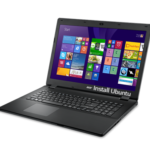Here is How to install Ubuntu from USB in Windows 10 which can work for both Windows and Linux. So without wasting time lets discuss USB boot guide for your installing Ubuntu by using Windows 10.
What is Boot from USB?
- It is a process of starting a Computer operating system from the USB drive.
- Booting from USB enables to get booting information in a USB rather than using a hard disk or the CD drive.
- All new operating systems support to boot from USB.
About Ubuntu
- Ubuntu is a free and open-source Linux Debian operating system.
- Also, Ubuntu offers three editions Desktop, server, cloud, and Ubuntu core.
- It provides new releases every 6 months while LTS occurs every 2 years.
- Ubuntu is developed by Canonical which provides free security updates and support to its users.
- Furthermore, for installing Ubuntu 18.04 LTS on Windows 10 you should meet minimum requirements such as 2GB RAM, Dual Core Processor (2 GH) and 25 GB free space.
Advantages of installing Ubuntu
- It is free of cost while the official Windows operating system is chargeable.
- Ubuntu is customizable while on Windows you can only customize some components.
- It is more secure.
- Runs without installing.
- Ubuntu is good for developers.
- It can be updated without restarting.
- Lastly, Ubuntu provides more resources.
About Windows 10
- Windows 10 is one of the family members of Operating systems developed by Microsoft.
- It is the latest development by Microsoft by being the successor of Windows 8.1 which was released on July 15, 2015.
- This operating system has got many positive reviews and is being praised for its design and features.
Read Also –
- How to Boot Kali Linux from USB in Windows 10: Complete Guide
- Can I install Windows 10 on iPhone X, if yes then How?
- Is it safe to Download Windows 10 64bit crack from Kickass
Advantages of Booting from USB?
There are many advantages of Booting from USB over other booting options such as DVD and other which are discussed below,
- No need to purchase any blank CD and you can fill your own stuff along with the ISO file.
- USB Drives are reusable
- Faster read and write than CD
- Very convenient and portable
Disadvantages of Booting from USB
- Booting from USB is depended on the Hardware such as BIOS, motherboard and flash drive model as it may be working with one computer and refuses to another.
- CD has wider support and USB boot functionality is not available for may operating system.
Ways to Boot From USB in Windows 10
1. Boot Ubuntu from USB using Rufus
Download Rufus

- After installing Rufus simply select the ISO file from the file manager and accept all settings when the popup window appears.
- Finally, start the process and this software will automatically format and create bootable USB flash drive.
2. Windows 10 Boot from USB using Unetbootin
UNetbootin enables you to create a bootable USB drive for Live operating system for Ubuntu and other Linux distributions. To create a Bootable Live USB drive follow the instructions below,
Download UNetbootin for Windows
- UNetbootin installs the Linux Distros ISO files for you if you want to use your own downloaded ISO file then follow instructions below,

- To use already downloaded ISO file select the disk image option and provide the location of the file by clicking “…”.
- After selecting the Linux Distribution or ISO file Format your USB drive as FAT32.
- Target the USB drive on your Windows 10 PC and click on OK.
- The process will automatically start and in case the installation doesn’t complete you can reformat USB as FAT32.
3. By using Universal USB Installer
Download Universal USB Installer- Using Universal USB Installer is the easiest way to create a live Linux USB or bootable USB.
- All you need to do is selecting the ISO file, your Flash Drive and, finally, Click Install.
- The process will automatically start and you will receive a ready bootable USB Flash Drive.
Change boot-order to boot from USB in Windows 10 PC
- Turn your PC off
- Now connect the bootable USB stick to the port.
- Get into BIOS and change the boot order to USB by following instructions on the screen.
- Finally, Reboot your Laptop
Now you have successfully created a bootable USB drive which is ready to install Ubuntu operating system on your Windows PC. Follow some steps below to install Ubuntu from USB in Windows 10.
instructions to install Ubuntu from USB on Windows 10
Make sure you have the latest Ubuntu Operating system Downloaded from the official Site, if not then download it from the official website. This procedure can erase all your data so make sure you have a backup of all your files.
Boot from the Drive USB/DVD
- After successfully booting your USB stick you need to turn off your Windows 10 PC to install Ubuntu on it.
- Insert the USB in port and once you will restart your laptop the screen presenting “Try Ubuntu” and “Install Ubuntu” will be shown to you.
- You can either try ubuntu or install Ubuntu, Although Try option is for testing the operating system this process will also take some time.
- So if you are continuing with install Ubuntu then read the further guide.
4. Installing Ubuntu 18.04
There are many steps in the process of installing Ubuntu with USB on Windows 10 which will be provided step-by-step below,
1. Choosing Keyboard
- Choose a keyboard layout and click Continue and by default English option is selected.
- Now you have to choose a type of installation as there are two types – Normal and Minimal installation. In our case, we have preferred the normal installation.
- Downloading updates while installing must be turned off for a faster installation.
- install third-party software for graphics and Wi-Fi hardware, MP3 and additional media formats should be selected only is internet connection is available while installation.
- Finally, click continue to proceed.
2. Selecting the installation type
Installation options,
- Erase the whole disk and install the Ubuntu: It is the easiest way to install Ubuntu on your Windows 10 PC. A fresh copy will be installed on your Laptop by erasing all the stored data on your PC.
- For security Encrypting new Ubuntu installation for security: Not to worry about this option as this option will ensure the security of your drives.
- Using LVM: LVM or Logical Volume Management
- Something Else: Use this option if you want to install Ubuntu along with existing Operating system such as Windows 10 which is known as Dual booting. In addition, only select this option if you are familiar with such technical task.
3. Creating Partitions for Something Else Option
- To create the partition on your own you can click “New Partition Table”
- Click on Continue and create a /boot partition of size 1.5GB. Select free space and click on the “+” symbol for creating a new partition.
- Now click on OK
- Let’s create the /home partition of size more than 18GB.
- Next, create partitions / of 6GB and /var of 4GB by using the process we have discussed with you.
- Lastly, Create the swap area partition of 2GB.
- Check that all the partitions are made correctly or not. Once you have created the partitions successfully you can proceed to the further steps by clicking Install Now.
5. Selecting Time Zone
Choose the desired time zone and click on continue
6. Providing user credentials
Give your information to the page prompted to you. The page will ask your name, computers name, username, and the password. Finally, click on continue to begin the process of installing Ubuntu 18.04 LTS on your Windows 10 PC.
7. Start installation
Installation may take around 5 to 10 minutes on your Microsoft Laptop which may depend on the speed of Laptop.
8. Restart and Login
Restart your computer and enter the login details you have provided previously in User credentials.
Welcome to Ubuntu
You have finally installed Ubuntu with USB on your Windows 10 PC. Enjoy,
Discuss any problem on Infofuge and start by Asking a Question








